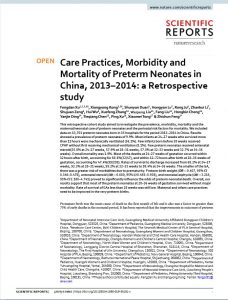
This study aimed to analyze outcomes in antenatal and postnatal care, morbidities, mortality and the perinatal risk factors for preterm neonatal mortality among preterm neonates born in 15 hospitals in China from January 1, 2013 to December 31, 2014.It included data on 13,701 preterm neonates born in 15 hospitals for the period 2013–2014 in China.
Results showed a prevalence of preterm neonates of 9.9%. Most infants at 24–27 weeks who survived more than 12 hours were mechanically ventilated (56.1%). Few infants born before 28 weeks received CPAP without first receiving mechanical ventilation (8.1%). Few preterm neonates received antenatal steroid(35.8% at 24–27 weeks, 57.9% at 28–31 weeks, 57.0% at 32–33 weeks and 32.7% at 34–36 weeks). Overall mortality was 1.9%. Most of the deaths at 24–27 weeks of gestation occurred within 12 hours after birth, accounting for 68.1%(32/47), and within 12–72 hours after birth at 28–36 weeks of gestation, accounting for 47.4%(99/209). Rates of survival to discharge increased from 68.2% at 24–27 weeks, 93.3% at 28–31 weeks, 99.2% at 32–33 weeks to 99.4% at 34–36 weeks. The smaller of the GA, there was a greater risk of morbidities due to prematurity. Preterm birth weight (OR = 0.407, 95% CI 0.346–0.478), antenatal steroid (OR = 0.680, 95% CI 0.493–0.938), and neonatal asphyxia (OR = 3.215, 95% CI 2.180–4.741) proved to significantly influence the odds of preterm neonatal death.
Overall, results support that most of the preterm neonates at 28–36 weeks of gestation survived without major morbidity. Rate of survival of GAs less than 28 weeks was still low. Maternal and infant care practices need to be improved in the very preterm births.